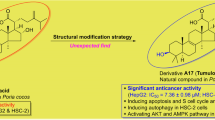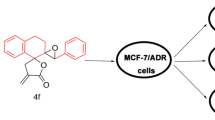Abstract
Xanthohumol (Xn) is a chalcone compound isolated from Humulus lupulus Linn., that has various biological activities. In this study, eight Xn derivatives were synthesized by Williamson, Mannich, Reimer-Tiemann, and Schiff base reactions, and evaluated for their in vitro cytotoxic activity against five human cancer cell lines (MDA-MB-231, MCF-7, CNE-2Z, SMMC-7721, and H1975). Among these compounds, 2-((E)-2,4-dihydroxy-5-((E)-3-(4-hydroxyphenyl)acryloyl)-6-methoxy-3-(3- methylbut-2-en-1-yl)benzylidene)hydrazine-1-carboximidamide (8) exhibited the most potent cytotoxic activity against the five cancer cells, with IC50 values ranging from 4.87 to 14.35 µM. Wound-healing and transwell assays showed that compound 8 inhibited the migration and invasion of MDA-MB-231 cells by down-regulation HIF-1α, MMP-2 and MMP-9 protein expression. We further demonstrated that compound 8 induced apoptosis of MDA-MB-231 cells by increasing of Bax/Bcl-2 ratio and down-regulation of Akt protein expression.






Similar content being viewed by others
References
Siegel RL, Miller KD, Fuchs HE, Jemal A (2022) Cancer statistics, 2022. CA Cancer J Clin 72(1):7–33. https://doi.org/10.3322/caac.21708
Sung H, Ferlay J, Siegel RL, Laversanne M, Soerjomataram I, Jemal A, Bray F (2021) Global Cancer Statistics 2020: GLOBOCAN estimates of incidence and Mortality Worldwide for 36 cancers in 185 countries. CA Cancer J Clin 71(3):209–249. https://doi.org/10.3322/caac.21660
Derakhshan F, Reis-Filho JS (2022) Pathogenesis of Triple-Negative breast Cancer. Annu Rev Pathol 17:181–204. https://doi.org/10.1146/annurev-pathol-042420-093238
Giaquinto AN, Sung H, Miller KD, Kramer JL, Newman LA, Minihan A, Jemal A, Siegel RL (2022) Breast Cancer Statistics, 2022. CA Cancer J Clin 72(6):524–541. https://doi.org/10.3322/caac.21754
Zhu Y, Hu Y, Tang C, Guan X, Zhang W (2022) Platinum-based systematic therapy in triple-negative breast cancer. Biochim Biophys Acta Rev Cancer 1877(1):188678. https://doi.org/10.1016/j.bbcan.2022.188678
Huppert LA, Gumusay O, Rugo HS (2022) Emerging treatment strategies for metastatic triple-negative breast cancer. Ther Adv Med Oncol 14:17588359221086916. https://doi.org/10.1177/17588359221086916
Newman DJ, Cragg GM (2020) Natural Products as sources of New Drugs over the nearly four decades from 01/1981 to 09/2019. J Nat Prod 83(3):770–803. https://doi.org/10.1021/acs.jnatprod.9b01285
Fabiani R (2020) Antitumoral Properties of Natural Products. Molecules 25(3):650. https://doi.org/10.3390/molecules25030650
Singla RK, Wang X, Gundamaraju R, Joon S, Tsagkaris C, Behzad S, Khan J, Gautam R, Goyal R, Rakmai J, Dubey AK, Simal-Gandara J, Shen B (2022) Natural products derived from medicinal plants and microbes might act as a game-changer in breast cancer: a comprehensive review of preclinical and clinical studies. Crit Rev Food Sci Nutr:1–45. https://doi.org/10.1080/10408398.2022.2097196
Coley HM (2008) Mechanisms and strategies to overcome chemotherapy resistance in metastatic breast cancer. Cancer Treat Rev 34(4):378–390. https://doi.org/10.1016/j.ctrv.2008.01.007
Guo D, Zhang B, Liu S, Jin M (2018) Xanthohumol induces apoptosis via caspase activation, regulation of Bcl-2, and inhibition of PI3K/Akt/mTOR-kinase in human gastric cancer cells. Biomed Pharmacother 106:1300–1306. https://doi.org/10.1016/j.biopha.2018.06.166
Zhang XL, Zhang YD, Wang T, Guo HY, Liu QM, Su HX (2015) Evaluation on antioxidant effect of Xanthohumol by different antioxidant Capacity Analytical Methods. J Chem 2014:1–6. https://doi.org/10.1155/2014/249485
Cermak P, Olsovska J, Mikyska A, Dusek M, Kadleckova Z, Vanicek J, Nyc O, Sigler K, Bostikova V, Bostik P (2017) Strong antimicrobial activity of xanthohumol and other derivatives from hops (Humulus lupulus L.) on gut anaerobic bacteria. APMIS 125(11):1033–1038. https://doi.org/10.1111/apm.12747
Yoshimaru T, Komatsu M, Tashiro E, Imoto M, Osada H, Miyoshi Y, Honda J, Sasa M, Katagiri T (2014) Xanthohumol suppresses oestrogen-signalling in breast cancer through the inhibition of BIG3-PHB2 interactions. Sci Rep 4:7355. https://doi.org/10.1038/srep07355
Vene R, Benelli R, Minghelli S, Astigiano S, Tosetti F, Ferrari N (2012) Xanthohumol impairs human prostate cancer cell growth and invasion and diminishes the incidence and progression of advanced tumors in TRAMP mice. Mol Med 18:1292–1302. https://doi.org/10.2119/molmed.2012.00174
Wang CM, Chen J, Zhao J, Hu SS, Zhang SQ, Mi XQ, Shi X, Cao XH, Li Z (2021) Xanthohumol induces ROS through NADPH oxidase, causes cell cycle arrest and apoptosis. Oxid Med Cell Longev 2021:9877170. https://doi.org/10.1155/2021/9877170
Monteiro R, Becker H, Azevedo I, Calhau C (2006) Effect of hop (Humulus lupulus L.) flavonoids on aromatase (estrogen synthase) activity. J Agric Food Chem 54(8):2938–2943. https://doi.org/10.1021/jf053162t
Żołnierczyk AK, Baczyńska D, Potaniec B, Kozłowska J, Grabarczyk M, Woźniak E, Anioł M (2017) Antiproliferative and antioxidant activity of xanthohumol acyl derivatives. Med Chem Res 26(8):1764–1771. https://doi.org/10.1007/s00044-017-1887-9
Zhang B, Duan D, Ge C, Yao J, Liu Y, Li X, Fang J (2015) Synthesis of xanthohumol analogues and discovery of potent thioredoxin reductase inhibitor as potential anticancer agent. J Med Chem 58(4):1795–1805. https://doi.org/10.1021/jm5016507
Vogel S, Barbic M, Jurgenliemk G, Heilmann J (2010) Synthesis, cytotoxicity, anti-oxidative and anti-inflammatory activity of chalcones and influence of A-ring modifications on the pharmacological effect. Eur J Med Chem 45(6):2206–2213. https://doi.org/10.1016/j.ejmech.2010.01.060
Vogel S, Ohmayer S, Brunner G, Heilmann J (2008) Natural and non-natural prenylated chalcones: synthesis, cytotoxicity and anti-oxidative activity. Bioorg Med Chem 16(8):4286–4293. https://doi.org/10.1016/j.bmc.2008.02.079
Harish V, Haque E, Smiech M, Taniguchi H, Jamieson S, Tewari D, Bishayee A (2021) Xanthohumol for Human Malignancies: Chemistry, Pharmacokinetics and Molecular targets. Int J Mol Sci 22(9):4478. https://doi.org/10.3390/ijms22094478
Legette L, Ma L, Reed RL, Miranda CL, Christensen JM, Rodriguez-Proteau R, Stevens JF (2012) Pharmacokinetics of xanthohumol and metabolites in rats after oral and intravenous administration. Mol Nutr Food Res 56(3):466–474. https://doi.org/10.1002/mnfr.201100554
Nookandeh A, Frank N, Steiner F, Ellinger R, Schneider B, Gerhauser C, Becker H (2004) Xanthohumol metabolites in faeces of rats. Phytochemistry 65(5):561–570. https://doi.org/10.1016/j.phytochem.2003.11.016
Avula B, Ganzera M, Warnick JE, Feltenstein MW, Sufka KJ, Khan IA (2004) High-performance liquid chromatographic determination of xanthohumol in rat plasma, urine, and fecal samples. J Chromatogr Sci 42(7):378–382. https://doi.org/10.1093/chromsci/42.7.378
Ottewell PD, O’Donnell L, Holen I (2015) Molecular alterations that drive breast cancer metastasis to bone. Bonekey Rep 4:643. https://doi.org/10.1038/bonekey.2015.10
Ou M, Sun X, Liang J, Liu F, Wang L, Wu X, Tu J (2017) A polysaccharide from Sargassum thunbergii inhibits angiogenesis via downregulating MMP-2 activity and VEGF/HIF-1alpha signaling. Int J Biol Macromol 94:451–458. https://doi.org/10.1016/j.ijbiomac.2016.10.046
Choi JY, Jang YS, Min SY, Song JY (2011) Overexpression of MMP-9 and HIF-1alpha in breast Cancer cells under hypoxic conditions. J Breast Cancer 14(2):88–95. https://doi.org/10.4048/jbc.2011.14.2.88
Hengartner MO (2000) The biochemistry of apoptosis. Nature 407(6805):770–776. https://doi.org/10.1038/35037710
Yuan L, Cai Y, Zhang L, Liu S, Li P, Li X (2021) Promoting apoptosis, a Promising Way to treat breast Cancer with Natural Products: a Comprehensive Review. Front Pharmacol 12:801662. https://doi.org/10.3389/fphar.2021.801662
Osaki M, Oshimura M, Ito H (2004) PI3K-Akt pathway: its functions and alterations in human cancer. Apoptosis 9(6):667–676. https://doi.org/10.1023/B:APPT.0000045801.15585.dd
Nimmanapalli R, O’Bryan E, Kuhn D, Yamaguchi H, Wang HG, Bhalla KN (2003) Regulation of 17-AAG-induced apoptosis: role of Bcl-2, Bcl-XL, and bax downstream of 17-AAG-mediated down-regulation of akt, Raf-1, and src kinases. Blood 102(1):269–275. https://doi.org/10.1182/blood-2002-12-3718
Acknowledgements
This work was financially supported by the Anhui Provincial Natural Science Foundation (2008085MH284); 512 Talent Cultivation Plan of Bengbu Medical College (By51202202); Anhui Engineering Technology Research Center of Biochemical Pharmaceutical Foundation (2022SYKFZ03).
Author information
Authors and Affiliations
Contributions
Conceptualization, C.-Z.W. and Y.-X.Z.; methodology, X.-L.S., J.C.; software, F.D. and L.Z.; investigation, J.C. and X.-S. W.; formal analysis, L.Z.; data curation, F.D.; writing—original draft preparation, X.-L.S. and H.-M.L.; writing—review and editing, X.-S. W. and H.-M.L.; supervision, C.-Z.W., and Y.-X.Z.; project administration, C.-Z.W. and X.-L.S.; funding acquisition, C.-Z.W. All authors have read and agreed to the published version of the manuscript.
Corresponding authors
Ethics declarations
Competing interests
The authors declare no competing interests.
Additional information
Publisher’s Note
Springer Nature remains neutral with regard to jurisdictional claims in published maps and institutional affiliations.
Electronic supplementary material
Below is the link to the electronic supplementary material.
Rights and permissions
Springer Nature or its licensor (e.g. a society or other partner) holds exclusive rights to this article under a publishing agreement with the author(s) or other rightsholder(s); author self-archiving of the accepted manuscript version of this article is solely governed by the terms of such publishing agreement and applicable law.
About this article
Cite this article
Sun, X., Chen, J., Huang, D. et al. Semi-synthesis and in vitro anti-cancer effects evaluation of novel xanthohumol derivatives. Mol Divers (2023). https://doi.org/10.1007/s11030-023-10706-7
Received:
Accepted:
Published:
DOI: https://doi.org/10.1007/s11030-023-10706-7




